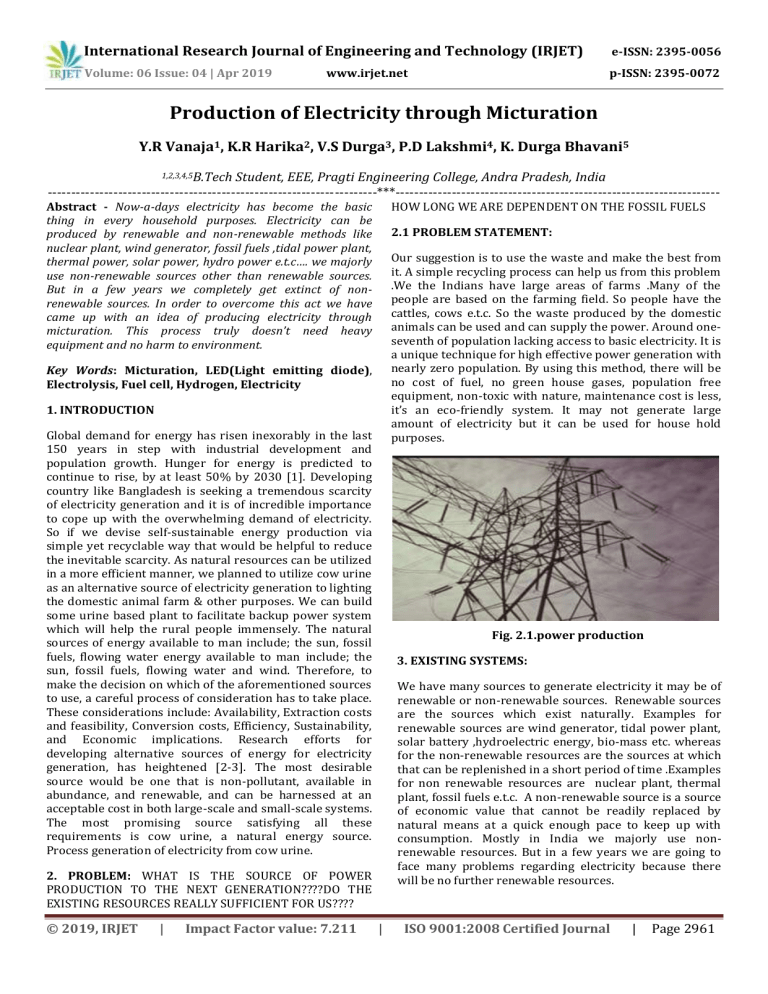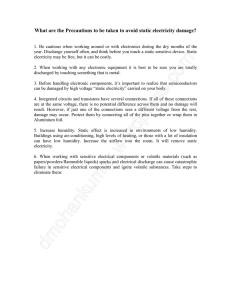IRJET-Production of Electricity through Micturation
advertisement

International Research Journal of Engineering and Technology (IRJET) e-ISSN: 2395-0056 Volume: 06 Issue: 04 | Apr 2019 p-ISSN: 2395-0072 www.irjet.net Production of Electricity through Micturation Y.R Vanaja1, K.R Harika2, V.S Durga3, P.D Lakshmi4, K. Durga Bhavani5 1,2,3,4,5B.Tech Student, EEE, Pragti Engineering College, Andra Pradesh, India ----------------------------------------------------------------------***--------------------------------------------------------------------Abstract - Now-a-days electricity has become the basic thing in every household purposes. Electricity can be produced by renewable and non-renewable methods like nuclear plant, wind generator, fossil fuels ,tidal power plant, thermal power, solar power, hydro power e.t.c…. we majorly use non-renewable sources other than renewable sources. But in a few years we completely get extinct of nonrenewable sources. In order to overcome this act we have came up with an idea of producing electricity through micturation. This process truly doesn’t need heavy equipment and no harm to environment. HOW LONG WE ARE DEPENDENT ON THE FOSSIL FUELS 2.1 PROBLEM STATEMENT: Our suggestion is to use the waste and make the best from it. A simple recycling process can help us from this problem .We the Indians have large areas of farms .Many of the people are based on the farming field. So people have the cattles, cows e.t.c. So the waste produced by the domestic animals can be used and can supply the power. Around oneseventh of population lacking access to basic electricity. It is a unique technique for high effective power generation with nearly zero population. By using this method, there will be no cost of fuel, no green house gases, population free equipment, non-toxic with nature, maintenance cost is less, it’s an eco-friendly system. It may not generate large amount of electricity but it can be used for house hold purposes. Key Words: Micturation, LED(Light emitting diode), Electrolysis, Fuel cell, Hydrogen, Electricity 1. INTRODUCTION Global demand for energy has risen inexorably in the last 150 years in step with industrial development and population growth. Hunger for energy is predicted to continue to rise, by at least 50% by 2030 [1]. Developing country like Bangladesh is seeking a tremendous scarcity of electricity generation and it is of incredible importance to cope up with the overwhelming demand of electricity. So if we devise self-sustainable energy production via simple yet recyclable way that would be helpful to reduce the inevitable scarcity. As natural resources can be utilized in a more efficient manner, we planned to utilize cow urine as an alternative source of electricity generation to lighting the domestic animal farm & other purposes. We can build some urine based plant to facilitate backup power system which will help the rural people immensely. The natural sources of energy available to man include; the sun, fossil fuels, flowing water energy available to man include; the sun, fossil fuels, flowing water and wind. Therefore, to make the decision on which of the aforementioned sources to use, a careful process of consideration has to take place. These considerations include: Availability, Extraction costs and feasibility, Conversion costs, Efficiency, Sustainability, and Economic implications. Research efforts for developing alternative sources of energy for electricity generation, has heightened [2-3]. The most desirable source would be one that is non-pollutant, available in abundance, and renewable, and can be harnessed at an acceptable cost in both large-scale and small-scale systems. The most promising source satisfying all these requirements is cow urine, a natural energy source. Process generation of electricity from cow urine. Fig. 2.1.power production 3. EXISTING SYSTEMS: We have many sources to generate electricity it may be of renewable or non-renewable sources. Renewable sources are the sources which exist naturally. Examples for renewable sources are wind generator, tidal power plant, solar battery ,hydroelectric energy, bio-mass etc. whereas for the non-renewable resources are the sources at which that can be replenished in a short period of time .Examples for non renewable resources are nuclear plant, thermal plant, fossil fuels e.t.c. A non-renewable source is a source of economic value that cannot be readily replaced by natural means at a quick enough pace to keep up with consumption. Mostly in India we majorly use nonrenewable resources. But in a few years we are going to face many problems regarding electricity because there will be no further renewable resources. 2. PROBLEM: WHAT IS THE SOURCE OF POWER PRODUCTION TO THE NEXT GENERATION????DO THE EXISTING RESOURCES REALLY SUFFICIENT FOR US???? © 2019, IRJET | Impact Factor value: 7.211 | ISO 9001:2008 Certified Journal | Page 2961 International Research Journal of Engineering and Technology (IRJET) e-ISSN: 2395-0056 Volume: 06 Issue: 04 | Apr 2019 p-ISSN: 2395-0072 www.irjet.net battery, commonly used for portable electrical devices. It was developed in comparison, the first wet cells were typically fragile glass containers with lead rods hanging from the open top and needed careful handling to avoid spillage. Lead–acid batteries did not achieve the safety and portability of the dry cell until the development of the gel battery. Wet cells have continued to be used for high-drain applications, such as starting internal combustion engines, because inhibiting the electrolyte flow tends to reduce the current capability. 4. PROCESS We actually take three dry cells of 1.5 volts. We need to remove the steel coverings of the dry cell which are present on the outer most of the cell. All we use is the ferroide rod and the zinc plate .Initially we check the voltage generated by the empty dry cell. The voltage generated by the cell at which there is no medium is zero volts. Later pour the cow micturation in the dry cell then there will be a voltage of 1.28Volts. Now we need connect the three dry cells inorder to get some high voltage .The connection is to be made in series i.e., first cell positive is connected to second cell negative and the second cell positive is given to the third cell negative. Now there are two end terminals .The positive of third cell and the negative of first cell terminals are given to the probes of digital multimeter. Now we get a output of 3.57 volts Fig.5.1. dry cell inner components Fig.4.1 block diagram A common dry cell is the zinc-carbon cell, sometimes called the dry Leclanché cell, with a nominal voltage of 1.5 volts, the same as the alkaline cell (since both use the same zinc– manganese dioxide combination).A standard dry cell comprises a zinc anode, usually in the form of a cylindrical pot, with a carbon cathode in the form of a central rod. The electrolyte is ammonium chloride in the form of a paste next to the zinc anode. The remaining space between the electrolyte and carbon cathode is taken up by a second paste consisting of ammonium chloride and manganese dioxide, the latter acting as a depolariser. In some designs, often marketed as "heavy duty", the ammonium chloride is replaced with zinc chloride. 5. HARDWARE IMPLEMENTATION 5.1 BATTERY: We have taken a 1.5v battery and removed the outer steel coverings and also the carbon powder present in the zinc container. So here in this process we used zinc plate as cathode and ferroide rod as anode at which these are used in the generation of power. A dry cell is a type of electric battery, commonly used for portable electrical devices. It was developed in 1886 by the German scientist Carl Gassner, after development of wet zinc-carbon batteries by Georges Leclanché in 1866. The modern version was developed by Japanese Yai Sakizo in 1887.A dry cell uses a paste electrolyte, with only enough moisture to allow current to flow. Unlike a wet cell, a dry cell can operate in any orientation without spilling, as it contains no free liquid, making it suitable for portable equipment. By We have taken a 1.5v battery and removed the outer steel coverings and also the carbon powder present in the zinc container. So here in this process we used zinc plate as cathode and ferroide rod as anode at which these are used in the generation of power. A dry cell is a type of electric © 2019, IRJET | Impact Factor value: 7.211 5.2 DIGITAL MULTIMETER: A digital multimeter (DMM) is a test tool used to measure two or more electrical values—principally voltage (volts), current (amps) and resistance (ohms). It is a standard diagnostic tool for technicians in the electrical/electronic industries. Digital multimeter’s long ago replaced needle-based analog meters due to their ability to measure with greater accuracy, reliability and increased impedance. Fluke introduced its first digital multimeter in 1977. | ISO 9001:2008 Certified Journal | Page 2962 International Research Journal of Engineering and Technology (IRJET) e-ISSN: 2395-0056 Volume: 06 Issue: 04 | Apr 2019 p-ISSN: 2395-0072 www.irjet.net Digital multimeter’s combine the testing capabilities of single-task meters—the voltmeter (for measuring volts), ammeter (amps) and ohmmeter (ohms). Often they include a number of additional specialized features or advanced options. Technicians with specific needs, therefore, can seek out a model targeted for particular tasks. Here we used it for measuring DC voltage .Initially we kept the multimeter at 20 v. Positive and negative terminals are connected to the battery terminals. 5.4 CONNECTING WIRES: Connecting wires allows an electrical current to travel from one point on a circuit to another because electricity needs a medium through which it can move. Most of the connecting wires are made up of copper or aluminum. The face of a digital multimeter typically includes four components: Display: Where measurement readouts can be viewed. Buttons: For selecting various functions; the options vary by model. Dial (or rotary switch): For selecting primary measurement values (volts, amps, ohms). Input jacks: Where test leads are inserted. Copper is cheap and good conductivity. Instead of the copper, we can also use silver which has high conductivity but it is too costly to use. 5.5 LED: Test leads are flexible, insulated wires (red for positive, black for negative) that plug into the DMM. They serve as the conductor from the item being tested to the multimeter. The probe tips on each lead are used for testing circuits. A light emitting diode is a semi conductor light source that emits light when current flows through it. Electrons in the semi conductor recombined with electron holes, releasing energy in the form of photons. This effect is called Electroluminescence. The colour of the light is determined by the energy required for electrons to cross the band gap of the semi conductor device. LEDs have many advantages over incandescent light sources, including lower energy consumption, longer lifetime, improved physical robustness, smaller size, and faster switching. Lightemitting diodes are used in applications as diverse as aviation lighting, automotive headlamps, advertising, general lighting, traffic signals, camera flashes, lighted wallpaper and medical devices. The terms counts and digits are used to describe a digital multimeter's resolution—how fine a measurement a meter can make. By knowing a multimeter's resolution, a technician can determine if it is possible to see a small change in a measured signal. 5.3 MICTURATION: It is nothing but urination. Urine is a composition of urea af 2%.In this project we have used the cow urine as a medium to produce power.It is the wastage excreated by the cattle. © 2019, IRJET | Impact Factor value: 7.211 | ISO 9001:2008 Certified Journal | Page 2963 International Research Journal of Engineering and Technology (IRJET) e-ISSN: 2395-0056 Volume: 06 Issue: 04 | Apr 2019 p-ISSN: 2395-0072 www.irjet.net Unlike a laser, the color of light emitted from an LED is neither coherent nor monochromatic, but the spectrum is narrow with respect to human vision, and functionally monochromatic. fig.7.1 output voltage for a single dry cell CASE 2:In this we have taken three dry cells and removed their steel covering and carbon powder from their zinc containers and pour micturation in each dry cells and connected them in series using connecting wires like positive terminal of first dry cells is connected to negative terminal of second dry cell positive terminal of second dry cell is connected to negative terminal of third dry cell and positive terminal from third dry cell and negative terminal from first dry cell is taken out and connected to terminals of multimeter which is kept in dc voltage mode in 20v and measured the voltage it appears 3.57v . 6. PURPOSE OF THE PROJECT Here we are going to see some points regarding to purpose behind choosing this topic and what is the requirement of this type of the project in our day to day life Saves the non-renewable resources Saves electricity Easy installation Independent of other power productive systems No harm , less pollution Less expensive Installation cost is very less Eco-friendly Maintenance cost is low No fuels are required Micturation is easily available Fig.7.2 output voltage for three series combination of dry cells 7. RESULTS CASE 3: In this we taken three dry cells and removed their steel shell and carbon powder from the zinc container and pour micturation in to zinc containers and connected them in a series using connected wires positive terminal of first dry cell is connected to negative terminal of second terminal and positive terminal of second dry cell is connected to negative terminal of third dry cell and positive terminal of third dry cell and negative terminal of first dry cell are taken out and connected to the positive and negative terminals of LED then LED is brighten up. CASE 1: In this we have taken a single dry cell and removed outer steel covering and carbon powder present in zinc container and we poured micturation(cow urine) in to zinc container and voltage is measured by using multimeter by keeping the multi meter positive terminal on ferroide rod and negative terminal on zinc plate and a voltage of 1.28v is generated. © 2019, IRJET | Impact Factor value: 7.211 | ISO 9001:2008 Certified Journal | Page 2964 International Research Journal of Engineering and Technology (IRJET) e-ISSN: 2395-0056 Volume: 06 Issue: 04 | Apr 2019 www.irjet.net p-ISSN: 2395-0072 [8] http://www.indiaonlinepages.com/population/indiacurrent-population.html. [9] Nishant Aggarwal, Keshav Goyal, and Saran Narang, “Road Transport System Run by Hydrogen as a Fuel Generated through Urine” volume 1, Issue I, Feb2013, ISSN 2320-6802. BIOGRAPHIES Y.Ramya Vanaja studying B.Tech degree in Pragati engg college, India, from 2016. She is currently a final year B.Tech student of PEC(A3). Her primary research interest is in production of electricity Fig.7.3 led glowing by the voltage produced by series combined dry cells 8. CONCLUSION Hence from the above experiment we can determine that power can be produced by using cow micturation as the medium. We can use this method atleast for the house hold purposes in order to save the minimum of minimum power. The performance of the system is satisfactory. Here, to understand the feasibility of the system needs to build a longer scale of the system & test it for a longer period of time. Moreover options, processes and systems may vary to use cow’s urine based plant for households as well. K.Ratna Harika studying B.Tech degree in Pragati engg college, India, from 2016. She is currently a final year B.Tech student of PEC(A3) .Her primary research interest is in production of electricity V.Sai Durga studying B.Tech degree in Pragati engg college, India, from 2016. She is currently a final year B.Tech student of PEC(A3). Her primary research interest is in production of electricity ACKNOWLEDGEMENT We would like to thank our Principal Dr. Sambhu Prasad, Head of the Department, Prof. K.Satya narayana and my guide Asst. Prof S.Varalakshmi for their valuable advice and technical assistance. REFERENCES [1] http://www.epa.gov/iris/toxreviews/1022tr.pdf. [2] Breeze, Paul. Power Generation Technologies: Evaluating the Cost of Electricity. London: Financial Times Energy, 1998 [3] How stuff works, Research on Applied Bioelectrochemistry, Quarterly Progress, article on urea electrolysis by K.BOGGS,Appleby, A. John. Fuel Cell Handbook. New York: Van Reinhold Co., 1989. [4] Bryan K. Boggs, Rebecca L.King and Gerardine G. Botte, “Urea electrolysis: direct hydrogen production from urine” DOI: 10.1039/b905974a. [5] http://www.pnl.gov/fuelcells/docs/permitguides/module1_final.pdf. [6] http://www.clarkson.edu/highschool/k12/project/d ocuments/ene rgysystems/lp_3fuelcell.pdf. [7] http://www.worldometers.info/. © 2019, IRJET | Impact Factor value: 7.211 P.Dhana Lakshmi studying B.Tech degree in Pragati engg college, India, from 2016. She is currently a final year B.Tech student of PEC(A3). Her primary research interest is in production of electricity K. Durga Bhavani studying B.Tech degree in Pragati engg college, India, from 2016. She is currently a final year B.Tech student of PEC(A3) .Her primary research interest is in production of electricity | ISO 9001:2008 Certified Journal | Page 2965




